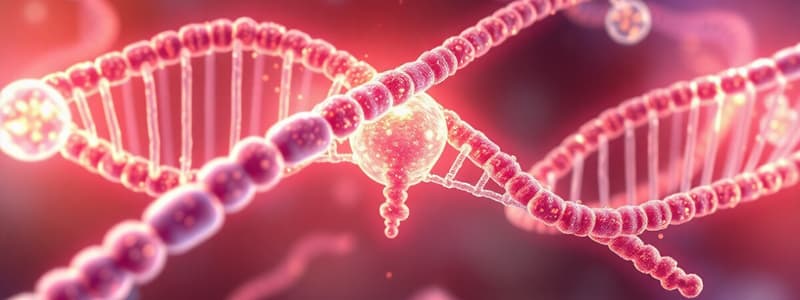Podcast
Questions and Answers
Briefly explain the central dogma of molecular genetics, highlighting the roles of DNA, RNA, and protein. How do these three molecules contribute to the flow of genetic information within a cell?
Briefly explain the central dogma of molecular genetics, highlighting the roles of DNA, RNA, and protein. How do these three molecules contribute to the flow of genetic information within a cell?
The central dogma describes the flow of genetic information: DNA is transcribed into RNA, which is then translated into protein. DNA stores the genetic code, RNA carries the code, and proteins perform various functions.
Describe the process of transcription. What enzyme is primarily responsible of this process, and what is the final product?
Describe the process of transcription. What enzyme is primarily responsible of this process, and what is the final product?
Transcription is the process of copying genetic information from DNA to mRNA. RNA polymerase is the primary enzyme. The final product is mRNA, which carries the DNA code out of the nucleus.
Explain the function of transfer RNA (tRNA) in translation. How does tRNA contribute to the assembly of a polypeptide chain?
Explain the function of transfer RNA (tRNA) in translation. How does tRNA contribute to the assembly of a polypeptide chain?
tRNA carries specific amino acids to the ribosome during translation. It has an anticodon complementary to the mRNA codon, ensuring the correct amino acid is added to the growing polypeptide chain.
What is a codon, and how is it related to the sequence of amino acids in a protein? Explain the relationship between codons and anticodons during translation.
What is a codon, and how is it related to the sequence of amino acids in a protein? Explain the relationship between codons and anticodons during translation.
Describe the translation process. Where does it take place, and what are the main components required for a polypeptide chain to be synthesized?
Describe the translation process. Where does it take place, and what are the main components required for a polypeptide chain to be synthesized?
Explain why DNA cannot leave the nucleus but RNA can. How does this structural difference facilitate the process of protein synthesis?
Explain why DNA cannot leave the nucleus but RNA can. How does this structural difference facilitate the process of protein synthesis?
Briefly describe how the proteins we eat contribute to the synthesis of new proteins in our bodies. What role do amino acids play in this process?
Briefly describe how the proteins we eat contribute to the synthesis of new proteins in our bodies. What role do amino acids play in this process?
Besides building body tissue, fighting disease and acting as enzymes, what other important function do proteins play in a cell? Give a brief description.
Besides building body tissue, fighting disease and acting as enzymes, what other important function do proteins play in a cell? Give a brief description.
Flashcards
What are Proteins?
What are Proteins?
Proteins are molecules made of amino acids and are essential to all living organisms.
Amino Acid Variety
Amino Acid Variety
There are 20 different amino acids, and proteins are made by combining these in various sequences.
What makes proteins?
What makes proteins?
Ribosomes manufacture (make) proteins.
Protein functions?
Protein functions?
Signup and view all the flashcards
Transcription
Transcription
Signup and view all the flashcards
DNA vs. RNA Location
DNA vs. RNA Location
Signup and view all the flashcards
Translation
Translation
Signup and view all the flashcards
tRNA's Role
tRNA's Role
Signup and view all the flashcards
Study Notes
- Proteins constitute all living matter.
- Proteins are composed of amino acids.
- There are 20 different amino acids.
- Different proteins result from combining these amino acids in different combinations.
- Ribosomes manufacture (make) proteins.
- Proteins: fight disease, build new body tissue, act as enzymes for digestion and other chemical reactions, component of all cell membranes.
- Enzymes accelerate the rate of a reaction.
Transcription (Step 1 of Protein Making)
- Genetic information from DNA is copied to RNA through transcription.
- DNA contains the genetic code for proteins.
- Proteins are assembled by ribosomes located outside the nucleus, in the cytoplasm.
- DNA is too large to exit the nucleus and is double stranded , whereas RNA is single stranded.
- Part of a DNA strand briefly unzips and functions as a template to assemble complementary nucleotides into messenger RNA (mRNA).
- mRNA then passes through the pores of the nucleus, using the DNA code, and attaches to a ribosome.
Translation (Step 2 of Protein Making)
- Decoding of mRNA into a protein happens via translation
- Transfer RNA (tRNA) transports amino acids from the cytoplasm to the ribosome.
- Amino acids originate from consumed food.
- Proteins we eat are broken down and rearranged into new proteins as needed, directed by our DNA.
- A series of three adjacent bases in an mRNA molecule specify which amino acid to use; this is called a codon.
- Each tRNA codes for a different amino acid
- Nucleotides that are complementary to the codon in mRNA come from tRNA.
- mRNA carries DNA instructions, and tRNA carries amino acids to the ribosomes.
- Amino acids are joined together to make a protein, thereby creating a polypeptide.
- Polypeptide = Protein
Studying That Suits You
Use AI to generate personalized quizzes and flashcards to suit your learning preferences.




